The unassuming plate raise requires minimal loading and no learning curve to be effective. You grab a weight plate by either end, brace your core, and raise it to your face level for stronger and more muscular shoulders.
It may look straightforward — and it pretty much is — but there’s plenty worth learning to make the plate raise a worthwhile and effective addition to your program.
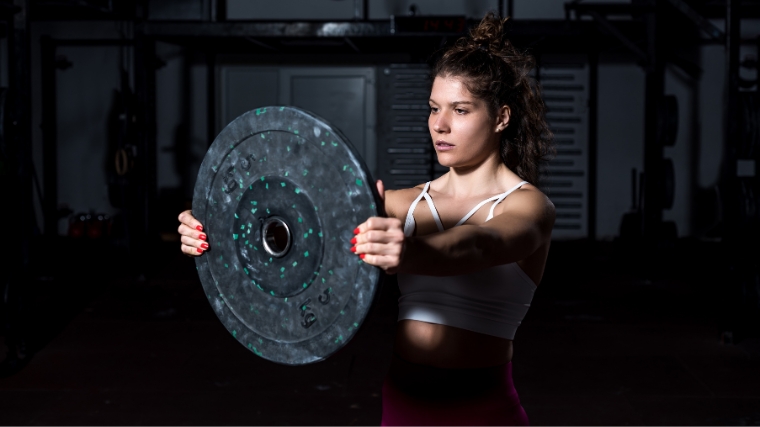
From the setup and execution to variations and alternatives, here is everything you need to know about the plate raise.
- How to Do the Plate Raise
- Plate Raise Sets and Reps
- Common Plate Raise Mistakes
- Plate Raise Variations
- Plate Raise Alternatives
- Muscles Worked by the Plate Raise
- Benefits of the Plate Raise
- Who Should Do the Plate Raise
- Frequently Asked Questions
How to Do the Plate Raise
The plate raise leverages the equipment already found in most gyms and the natural length of your arm to challenge your muscles. Here is the quick and dirty on set-up and execution.
Step 1 – Select the Right Weight
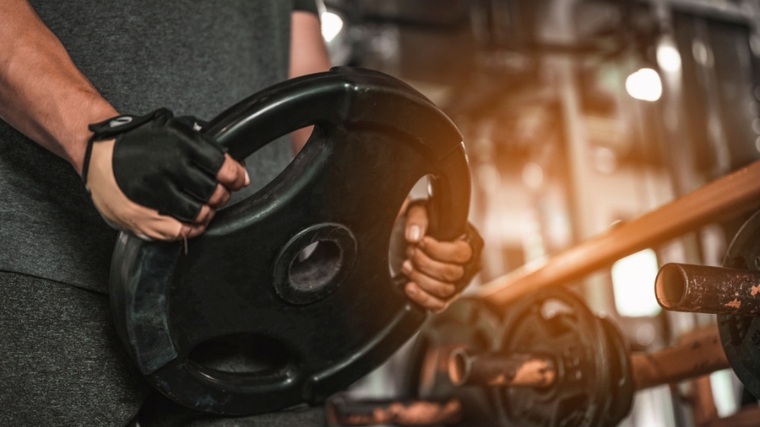
Find a weight plate, weighing anywhere from 5 to 45 pounds. (It’s okay, even encouraged, to go light during your first set as a warm-up.) Given the nature of the plate raise, the challenge will come from a combination of weight and long levers acting against you — so go lighter before ramping up once your technique is locked in.Coach’s Tip: Be patient when it comes to progressing the weight you use for plate raises; there are only so many weight increments available. When in doubt, add more reps first. Once you’re able to perform 20 reps comfortably, increase the weight by a plate size, usually in five pound increments.
Step 2 – Grip the Plate
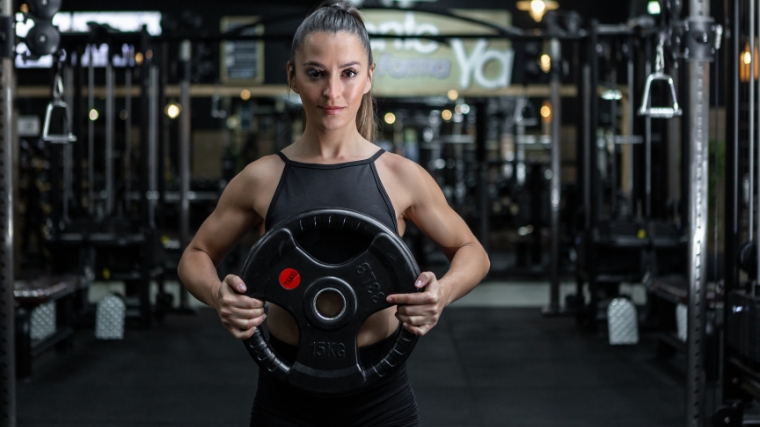
Grab the plate with both hands, palms facing each other. Some plates have handles, making this step easier. If you’re using plates without handles, squeeze the plate hard and be grateful for the improvement in grip strength.
Coach’s Tip: Don’t be afraid to cinch up your grip. A tighter squeeze will help with muscle irradiation (or increasing muscle tensions throughout your body) and aid with force production and stability.
Step 3 – Lift the Weight
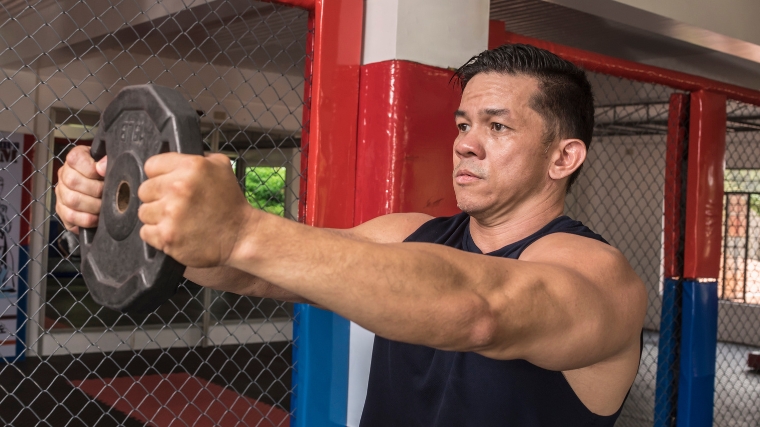
Keep a slight bend in your elbow to prevent unnecessary joint pain. Dig your feet into the floor, brace your core, and raise the plate from your hip to your face level. Pause for a beat at the apex of the movement and then lower the plate back to your hip with control.
Coach’s Tip: Try to relax your neck and shoulders. You don’t want to shrug your shoulders while raising the plate, though the traps are slightly involved in the exercise. Your aim should be to keep tension on your deltoid muscles.
Plate Raise Sets and Reps
You can use the plate raise to warm-up your shoulders before bench pressing, to build muscle mass in your deltoids, or to accumulate more shoulder muscle endurance. Here are different set and rep schemes for achieving any of those goals.
For Warming Up: Perform 1-2 sets of 12-20 repetitions using a light to moderate weight. Rest 45-60 seconds between each set.
For Building Muscle: Perform 2-3 sets of 8-12 repetitions using a moderate weight. Rest 2-3 minutes between each set.
For Muscle Endurance: Perform 2-3 sets of 15-20 repetitions with a light to moderate weight. Rest for only 30 seconds between each set.
Common Plate Raise Mistakes
The plate raise is a fairly straightforward exercise but it’s not without some common mistakes. Be careful not to go too heavy, use momentum, or hyperextend your back during the repetitions.
Going Too Heavy
One of the most common plate raise mistakes is lifting too much weight. The plate raise takes advantage of your arm length to increase the challenge — as you raise your arms, the weight moves farther away from your body creating more muscular tension and stress on the muscle. This extended range of motion means even a lighter plate may feel heavier than you’d expect.

[Read More: Best Pre-Workout Supplements]
If you find yourself unconsciously bending your arms earlier and earlier in your sets, this is an indicator that you’ve gone too heavy. When in doubt, start with a 10-pound plate and progress slowly from there.
Using Momentum
If you’re using body English to get the weight plate from point A to B, then you’re robbing your deltoids of muscle-building tension. The fix, however, is simple: Be aware of how you’re lifting the weight. Take a breath before you lift the plate, and raise it at a consistent pace. Control the weight from start to finish.
Hyperextending Your Back
Hyperextending — or arching your back in this case — will give you a false sense of range of motion. Where your arms should be raising the plate, a hyperextended back got you there instead. Maintain a brace core to lock your torso in the right position and be diligent about raising your arms, not extending your back.
Plate Raise Variations
There are several useful plate raise variations to weave into your repertoire. These can be complementary to the standard plate raise or stand-alone exercises.
Plate Pinch Front Raise
Wrap your hands around either side of two 10-pound plates stacked on top of one another. Functionally, this variation is the same as the standard plate raise. You’ll lift the weights from your hips to your face level. However, keeping the two plates pinched together adds a tremendous challenge to your hands and forearms.
If your sport requires a strong grip — like powerlifting, rock climbing, or Brazilian Jiu-Jitsu — give this variation a shot. Note that your hands and/or forearms may give out before your shoulder muscles.
Double-Plate Raise
Grab a plate in each hand, holding them at the top. (Either grab onto a handle or squeeze the plate firmly with your hand.)
[Read More: The Best Powerlifting Knee Sleeves You Can Buy]
The double-plate raise adds a unilateral aspect to your plate raise, challenging each of your arms to work independently of the other. These facts make the double-plate raise a great tool for muscle balance, increased challenge to stability, and scapular control.
Rotating Plate Raise
Equal parts plate raise and cable chop, the rotating plate raise has you lift a weight plate up and in a diagonal motion. Drawing the plate from your hips toward your left or right shoulder forces more core recruitment to keep your body stable.
The rotating plate raise is a core-strengthener and shoulder-builder in one unique package.
Bus Drivers
These smurf. Raise a plate to in front of your face and hold it steady. Now turn your hands to the left, like you’re using a steering wheel, and then turn them to the right. That’s one muscle-burning rep, and you’ll want to aim for 15-20.
Bus drivers are an isometric exercise that keeps an immense amount of tension on the target muscle.
Plate Raise Alternatives
When you’ve graduated from the plate raise or simply don’t have access to plates, here are some great alternatives to fill in on their behalf. Each fulfills nearly the same demand on your muscles with some subtly different benefits.
Cable Front Raise
The cable front raise can be performed anywhere you have access to a pin-loaded cable machine. Lower the pulley to the bottom position and attach a rope attachment or straight bar to the carabiner. Face away from the pulley, and then bend down to pull the attachment through your legs. Stand tall, holding the rope or bar with both hands. Raise the weight from your hips to chest height.
Compared to a weight plate, the cable stack provides a more consistent resistance throughout the movement’s range of motion, creating more tension on the muscle and making it a more challenging exercise overall.
Dumbbell Front Raise
The dumbbell front raise is a classic shoulder movement. It resembles the double-plate raise but offers a much better grip alternative. Since you should be able to close your grip around a dumbbell more securely than the plate raise, you can adequately load your muscles without grip being a limiting factor.
Perform the dumbbell front raise with both arms at the same time or in alternating fashion.
Kettlebell Front Raise
Similar to the dumbbell front raise, the kettlebell front raise is executed in the same fashion as the standard plate raise but uses a different implement.
[Read More: Best Grip Strengtheners]
Kettlebells allow you to close your grip around the handle, improving your ability to load the exercise. However, the kettlebell can be manipulated in a different way than the dumbbell. You can implement a neutral grip as an alternative, and since the kettlebell is non-uniformly loaded (more loading in the bell than the handle), it will dramatically increase the stability challenge.
Muscles Worked by the Plate Raise
The plate raise is an isolation movement, meaning it involves just one joint (your shoulder) and primarily targets one (or just a couple) of muscles. Keep reading for more information on how the plate raise impacts your anatomy.
Anterior Deltoids
The anterior deltoid is located on the lateral third of your collarbone and attaches to the deltoid tuberosity of your upper arm (pretty much smack dab in the middle of it). Based upon your arm path, this means that the anterior deltoids will be doing the majority of the “heavy lifting” for your plate raise.
Traps
The traps are a larger muscle group that have a wide range of attachment points across your back. The most important part of your traps as it relates to your plate raise will actually be the mid-to-low trap. Located around the shoulder blade area — these parts of your traps anchor your shoulders in the right place. While you perform the plate raise, the anterior deltoid will be working hard to raise the weight while the mid-to-low traps will be locking you in the right position.
Benefits of the Plate Raise
The plate raise will help pack on muscle, but is also beneficial for overall upper body warm-ups and helping to develop your lower traps.
More Shoulder Muscle
The anterior deltoids (front shoulder) are the major players in performing a plate raise. Since the plate raise requires lighter weights compared to shoulder press variations, they’re accessible for most every lifter. With the low barrier to entry on load and execution, plate raises can be a key factor in building huge delts.
They’re A Good Warm-Up Option
Given the significant number of muscles that assist during a plate raise, you can use it as a highly effective warm-up tool. Simply grab a low-to-moderate weight and perform a few quick sets of 12-20 repetitions. You’ll need to lock in your full body to brace your position. Take a few minutes off to recover and your entire upper body should be good to go for the rest of your workout.
They Build Your Lower Traps
Perhaps one of the most unsung benefits of the plate raise is the challenge it throws at your shoulder blades. The mid-to-low traps are responsible for controlling your scapula (shoulder blades) during most exercises. From pressing to pulldowns, the traps play a role in maintaining the proper position and overall stability.

[Read More: Lift Heavier and Protect Your Neck With the Best Trap Exercises]
With the plate raise in your program, you can keep an undoubtedly beneficial dose of low-to-mid trap stimulation in the mix at all times.
Who Should Do the Plate Raise
The plate raise is a relatively low-impact addition to almost any program that delivers a solid bang for your buck. Given all of its benefits, beginners, strength athletes, Olympic lifters, and bodybuilders will all benefit from the plate raise.
Beginners
Are you relatively new to lifting weights? Grab a light plate and start performing plate raises — it will help to build a lot of muscle and coordination that carries forward to numerous other exercises later in your development. From scapular control to bracing mechanics and muscle gain, this one is a real winner for beginners.
Strength Athletes
Strength athletes can benefit from the plate raise as a low-load alternative warm-up tool. Major barbell exercises require shoulder stability and bracing to execute. However, if you’re a strength athlete, you’re typically beat up all the time from the mandatory heavy weight of your programming. Utilizing the plate raise to warm-up the shoulders and mid back, and cue bracing is a great way to limit how much load is necessary to prepare with, leaving the heavier weights for your main training session.
Olympic Lifters
Trap stability and bracing is another hallmark trait of the Olympic lifter. If you’re routinely putting heavy weights over your head and demanding your shoulders and traps to keep everything locked up tight, a plate raise fits the bill.
[Read More: The Best Forearm Workouts]
While the loading is negligible compared to a snatch or power clean, that’s the specific benefit. Like strength athletes, a well executed plate raise for moderate to high repetitions can help grease the groove and get your upper back ready for action, minus the heavy weight.
Bodybuilders
Bodybuilders love a good burn out. While the plethora of benefits a plate raise offers applies to your bodybuilding needs as well, perhaps the most readily apartment benefit is its low-load finisher potential.
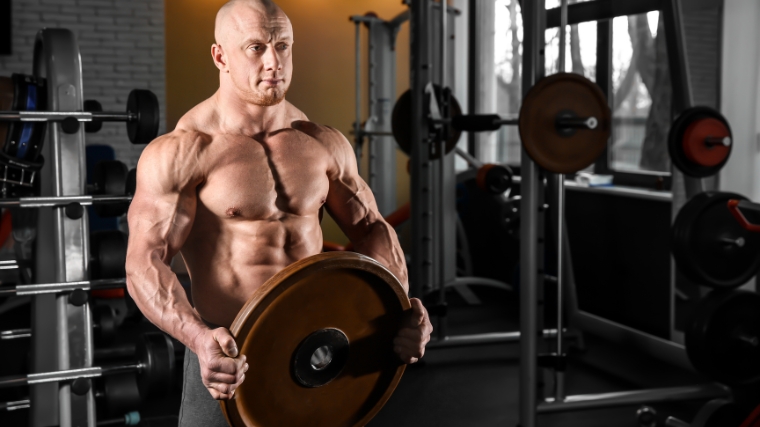
The plate raise can be the “flye” of the shoulders and traps. The long lever execution makes it a lightweight way to approach fatigue with higher repetitions at the end of the set. Toss it at the beginning or end of your workout as a warm-up or finisher and you’ll reap all the benefits.
Clean Your Plate
The plate raise is a simple exercise that doesn’t require a ton of fancy equipment or load to be effective. It takes the commonly found weight plate and turns it into a fantastic training tool with a huge amount of benefits.
With nearly zero barrier to entry, your plate raise can be a brutally effective warm-up movement, muscle-builder, or even used to build some endurance. Putting a ton of emphasis on scapular control and strict execution can have huge carry over benefits to strength, power, and any number of other exercise styles as well. Start tinkering with the plate raise and you might find that it sticks around as your new favorite so-simple-its-silly training tool.
FAQs
I feel a pinch in the front of my shoulder when executing a plate raise, what should I do?
Sometimes the plate raise doesn’t match your body size — particularly if you have a wider set of shoulders. If this is the case, using an Olympic lifting plate (for example, a 10-pound plate with the diameter of a 45-pound plate) can be a great solution. Oftentimes assuming a wider grip will alleviate any awkward friction during the range of motion. A second option would be any of the unilaterally loaded variations (such as the double-plate raise, dumbbell, or even kettlebell variations).
How heavy should I lift with my plate raise?
The plate raise uses physics to make the exercise more difficult. A longer arm (or lever) makes lighter weights feel heavier because the weight will be farther from the working muscle at the top of the movement. With this in mind, you won’t need to go very heavy to accomplish the results you’re looking for. Most of the time, 10 to 25 pounds should get the job done. Try adding more reps to the movement first and then slowly increase the load.
Are plate raises safe?
There is certainly inherent risk with any exercise, however if you are diligent in your execution the plate raise is no more dangerous than any other exercise. Be mindful of your set-up, brace, and controlled movement and you should be fine. If you have any doubts or questions, please consult with your doctor before trying any new exercise.
Featured Image: Srdjan Randjelovic / Shutterstock